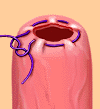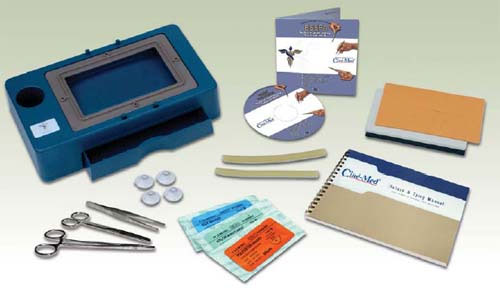
Running, or Continuous Stitch |
The "Running" stitch is made with one continuous length of suture material. Used to close tissue layers which require close approximation, such as the peritoneum. May also be used in skin or blood vessels. The advantages of the running stitch are speed of execution, and accommodation of edema during the wound healing process. However, there is a greater potential for malapproximation of wound edges than with the interrupted stitch. |
|

Interrupted Stitch |
Each stitch is tied separately. May be used in skin or underlying tissue layers. More exact approximation of wound edges can be achieved with this technique than with the running stitch. |
|

Mattress Suture |
A double stitch that is made parallel (horizontal mattress) or perpendicular (vertical mattress) to the wound edge. Chief advantage of this technique is strength of closure; each stitch penetrates each side of the wound twice, and is inserted deep into the tissue. |
|

Purse String |
A continuous stitch paralleling the edges of a circular wound. The wound edges are inverted when tied. Commonly used to close circular wounds, such as a hernia or an appendiceal stump. |
|

Smead-Jones/Far-and-Near |
A double loop technique alternating near and far stitches. Commonly used for approximating fascial edges. |
|

Continuous Locking, or Blanket Stitch |
A self-locking running stitch used primarily for approximating skin edges. |


![]() Back to Clinical Update Index
Back to Clinical Update Index